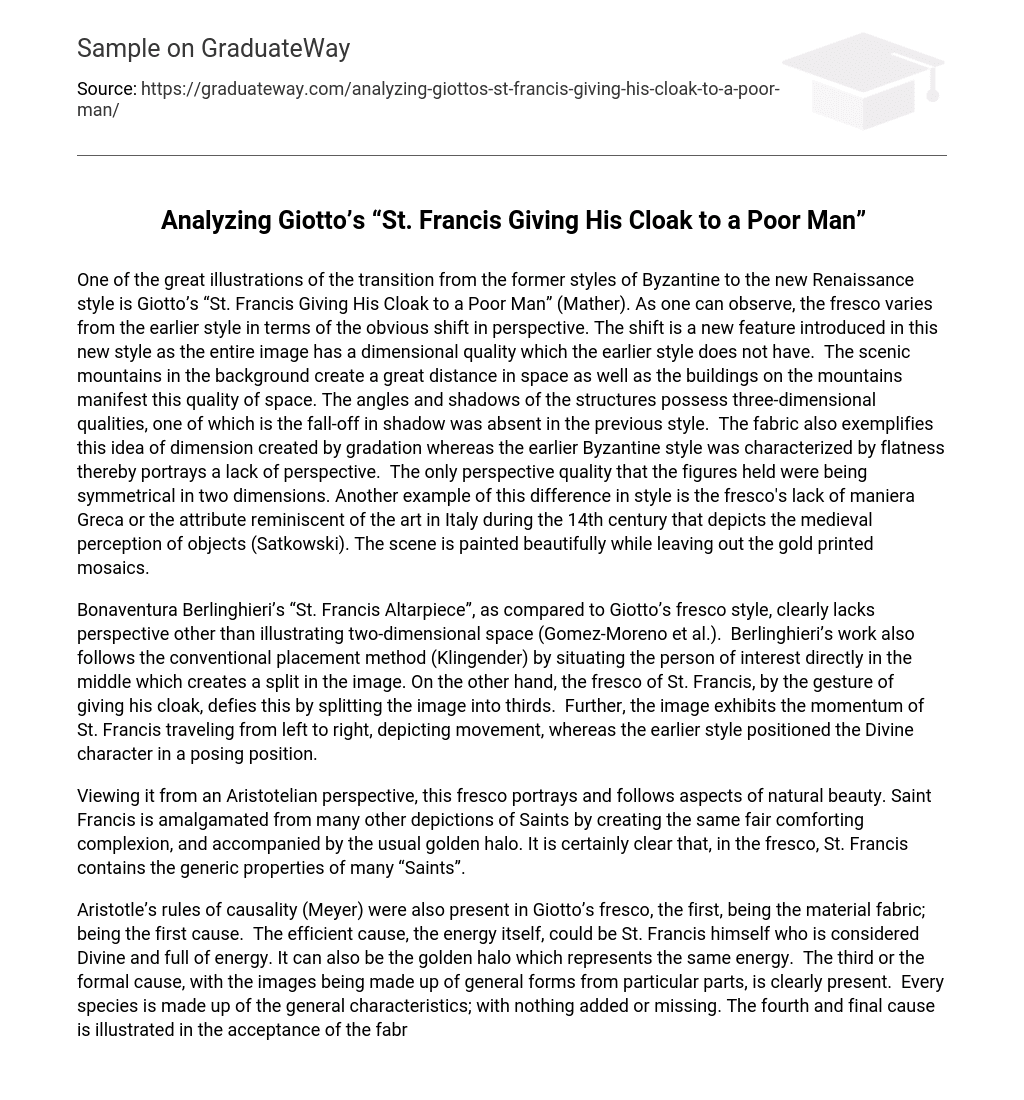One of the great illustrations of the transition from the former styles of Byzantine to the new Renaissance style is Giotto’s “St. Francis Giving His Cloak to a Poor Man” (Mather). As one can observe, the fresco varies from the earlier style in terms of the obvious shift in perspective. The shift is a new feature introduced in this new style as the entire image has a dimensional quality which the earlier style does not have. The scenic mountains in the background create a great distance in space as well as the buildings on the mountains manifest this quality of space. The angles and shadows of the structures possess three-dimensional qualities, one of which is the fall-off in shadow was absent in the previous style. The fabric also exemplifies this idea of dimension created by gradation whereas the earlier Byzantine style was characterized by flatness thereby portrays a lack of perspective. The only perspective quality that the figures held were being symmetrical in two dimensions. Another example of this difference in style is the fresco’s lack of maniera Greca or the attribute reminiscent of the art in Italy during the 14th century that depicts the medieval perception of objects (Satkowski). The scene is painted beautifully while leaving out the gold printed mosaics.
Bonaventura Berlinghieri’s “St. Francis Altarpiece”, as compared to Giotto’s fresco style, clearly lacks perspective other than illustrating two-dimensional space (Gomez-Moreno et al.). Berlinghieri’s work also follows the conventional placement method (Klingender) by situating the person of interest directly in the middle which creates a split in the image. On the other hand, the fresco of St. Francis, by the gesture of giving his cloak, defies this by splitting the image into thirds. Further, the image exhibits the momentum of St. Francis traveling from left to right, depicting movement, whereas the earlier style positioned the Divine character in a posing position.
Viewing it from an Aristotelian perspective, this fresco portrays and follows aspects of natural beauty. Saint Francis is amalgamated from many other depictions of Saints by creating the same fair comforting complexion, and accompanied by the usual golden halo. It is certainly clear that, in the fresco, St. Francis contains the generic properties of many “Saints”.
Aristotle’s rules of causality (Meyer) were also present in Giotto’s fresco, the first, being the material fabric; being the first cause. The efficient cause, the energy itself, could be St. Francis himself who is considered Divine and full of energy. It can also be the golden halo which represents the same energy. The third or the formal cause, with the images being made up of general forms from particular parts, is clearly present. Every species is made up of the general characteristics; with nothing added or missing. The fourth and final cause is illustrated in the acceptance of the fabric by the poor man, depicting the more general view of St. Francis helping the poverty-stricken. The horse, which is accompanying St. Francis, is also part of the material cause being the means of transportation.
Giotto’s fresco “St. Francis Giving His Cloak” is a good example of how this style changed from the earlier Byzantine. He was considered to be the Father of the Renaissance, and there is good reason why, being the catalyst that he has been.
References
Gomez-Moreno, Carmen, et al. “A Sienese St. Dominic Modernized Twice in the Thirteenth Century.” The Art Bulletin 51.4 (1969): 363.
Klingender, F. D. “St. Francis and the Birds of the Apocalypse.” Journal of the Warburg and Courtauld Institutes 16.1 (1953): 13.
Mather, Frank Jewett. “Giotto’s St. Francis Series at Assisi Historically Considered.” The Art Bulletin 25.2 (1943): 97.
Meyer, Susan Sauve. “Aristotle, Teleology, and Reduction.” The Philosophical Review 101.4 (1992): 791.
Satkowski, Leon. “Review: Giorgio Vasari: The Man and the Book by T. S. R. Boase.” The Journal of the Society of Architectural Historians 39.3 (1980): 244.





